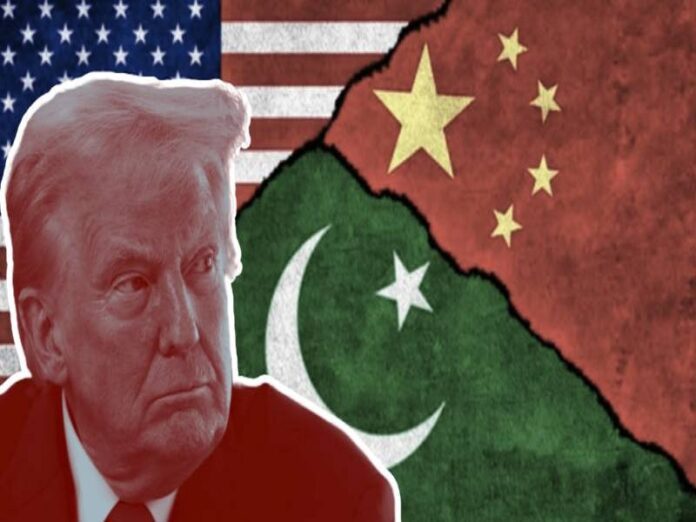Drop Site News published a report in early April about how “The State Department and the Pentagon Are Battling the Deep State Over the Future of India and China”, the gist of which is that those first two institutions are allegedly at odds with the CIA over the future of US-Pakistani ties. The State Department and the Pentagon “want to pivot away from the military and empower civilian leadership and democratic rule in Pakistan” while the CIA “sees the military and security establishment as a more reliable partner”.
The rationale is geopolitical since those who want to radically change the US’ decades-long policy with Pakistan, which Drop Site News’ unnamed sources assess is representative of the America First wing’s rising influence, envisage this greatly aiding the Trump Administration’s plans against China. According to them, “a civilian-led Pakistan will have a mandate to resolve its long-simmering conflict with India, freeing New Delhi to focus more directly on its eastern borders and act as a counterweight to China.”
While no means to the end of promoting civilian-led democratic rule in Pakistan were suggested in their report, a carrot-and-stick approach could be employed in pursuit of this goal. The most relevant issues that this policy could be applied towards concern Pakistan’s political agenda in Afghanistan (i.e. weakening Taliban rule), any potential anti-terrorist actions that it might undertake there, arms sales, tariffs, and trade with and investment from Russia. A few words will now be said about these subjects.
In brief, Taliban-ruled Afghanistan is suspected of harboring Islamabad-designated terrorists who’ve become Pakistan’s most pressing national security threat in recent years, ergo the need to either coerce its neighbor into kicking them out or punishing it for refusing to do so. American political and military assistance is respectively required in order to raise the chances of success. Failing to secure such before any major move in these directions risks the US branding Pakistan as a “rogue state” with all that entails.
On the topic of arms sales, the vast majority of Pakistan’s equipment comes from China, but it also fields a fleet of F-16s. These are formidable in and of themselves but also function to uphold bilateral ties. The US’ possible withholding of spares and/or decision not to sell any new equipment to Pakistan in the future, either of which could occur under the pretext of protesting its long-range missile program but really be about promoting political change, would thus escalate political tensions.
As for tariffs, the US is Pakistan’s largest export destination at approximately $6 billion a year, which amounts to 18% of total exports. Trump’s global trade war is therefore expected to hit its textile industry very hard according to reports, which could exacerbate the country’s economic-financial crisis and possibly lead to another round of political unrest if newly planned talks don’t swiftly resolve this issue. The economy is one of Pakistan’s weak points and the US could aggressively press its advantage.
Redirecting exports from the US to China in the event that a deal isn’t soon reached, which might be easier said than done, could mitigate the economic-financial consequences of Trump’s tariffs while worsening political ties with the US due to the Sino-American systemic rivalry. That might be self-defeating from the perspective of Pakistan’s overall interests since it could then prompt the previously mentioned military pressure on an anti-Chinese pretext and accelerate the US’ ongoing pivot to India.
About that, the scenario of being abandoned by America terrifies Pakistani policymakers since they fear the interconnected economic-financial, political (resultant large-scale protests), and regional security (vis-à-vis a fully US-backed India) consequences. Likewise, the US also wants to avoid that since it fears the global security consequences if nuclear-armed Pakistan “goes rogue” in revenge, especially if it’s emboldened by China. This balance of interests, or rather fears of the other, maintains the status quo.
At the same time, the current state of affairs impedes the America First wing’s “Pivot (back) to Asia” for more muscularly containing China since Pakistan continues providing the People’s Republic with reliable access to the Indian Ocean, thus facilitating Chinese exports to Europe and resource imports from Africa. The grand strategic significance is that Pakistan could partially neutralize the commercial impact of the US blockading the Strait of Malacca for Chinese ships during a crisis.
In exchange, Pakistan can rely on China for political, economic, and military support, all of which helps prevent Pakistan from falling too far behind India in the context of their decades-long rivalry. Accordingly, any concessions to the US that Pakistan might make on its relations with China risk being at the expense of its national security interests as policymakers understand them to be, though these might be manageable in two possibly connected scenarios.
The first is that more trade with and investment from Russia, which the US could encourage via sanctions waivers in the event that the nascent Russian–US “New Détente” evolves into a strategic partnership, could alleviate some of the economic-financial consequences from China. China might still continue arming Pakistan due to their shared threat perception of India, but it’s also possible that the US gradually replaces Pakistan’s reliance on Chinese arms, though at the expense of the US’ pivot to India.
The second scenario is that the Kashmir Conflict is finally resolved, which the America First wing reportedly believes requires civilian-led democratic rule in Pakistan, thus unlocking new economic-financial opportunities for replacing lost Chinese ones while reducing mutual threat perceptions. The abovementioned Russian and US roles would become more important than ever if that happens, but this best-case scenario from their perspective and India’s is less likely than the first, which itself is uncertain.
The public isn’t privy to the interplay between America’s two competing deep state factions on this issue so nobody can say with confidence exactly what’ll happen, only what each’s interests are and how the one pushing for radical change (the State Department and the Pentagon) could try to purse this. If the CIA prevails and the status quo is retained, then the Trump Administration risks having to curtail the scope of its “Pivot (back) to Asia” and could even be pulled back into Afghanistan by mission creep.
Drop Site News reported in early February that “Pakistan’s Military Hopes to Drag Trump Back into War in Afghanistan”, which would open a Pandora’s box of problems for him such as being very unpopular at home, imperiling the US’ pivot to India, and worsening already high tensions with Iran. On the other hand, abandoning Pakistan if it unilaterally intervenes in Afghanistan at scale without first securing US support could risk it “going rogue” in revenge as was earlier explained, thus creating a dilemma.
So long as Pakistan’s de facto military regime refuses to implement any (possibly US-pressured) concessions towards imprisoned former Prime Minister Imran Khan and continues to want to control his opposition party, thus making civilian-led democratic rule impossible, problems with the US will persist unless the CIA comes out on top in its competition with the State Department and the Pentagon. Whatever the outcome, it’ll have a huge impact on global affairs, hence the importance of following it.







